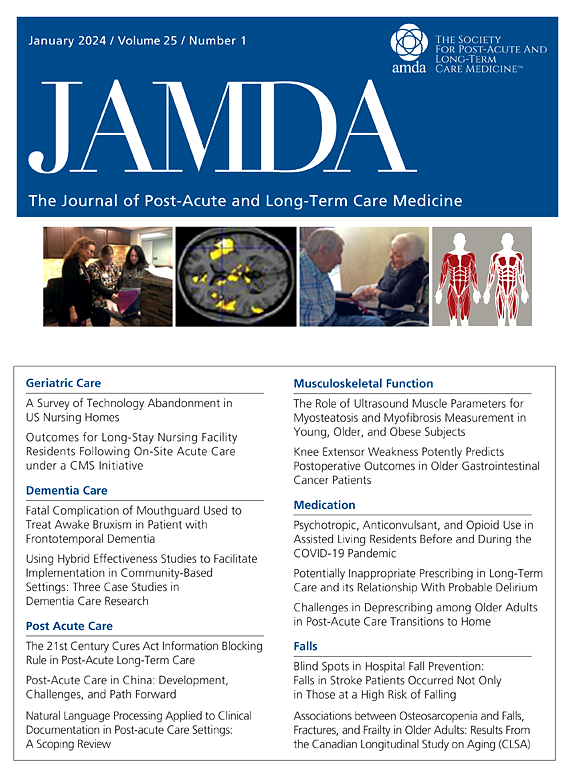无痴呆老年人的潜在认知特征和人口统计学决定因素:一项全国横断面研究。
IF 3.8
2区 医学
Q2 GERIATRICS & GERONTOLOGY
Journal of the American Medical Directors Association
Pub Date : 2025-06-10
DOI:10.1016/j.jamda.2025.105697
引用次数: 0
摘要
目的:传统的老年人认知幸福感分类往往忽略了特定领域的缺陷。我们旨在验证无痴呆患者的不同认知特征,并检查人口预测因子,以指导量身定制的干预措施,实现公平健康的老龄化。设计:横断面研究。环境/参与者:来自国家健康和老龄化趋势研究(NHATS)的≥65岁无痴呆的社区居住成年人。方法:对情景记忆、执行功能、定向、精神运动功能、视觉注意和工作记忆的识别潜在特征分析进行了分样本验证分析。多项逻辑回归用Holm-Bonferroni校正检验了每个剖面的人口统计学预测因子。结果:经过分样本验证分析,我们确认出现了5个潜在剖面(n = 2219):剖面1,整体完整(占所有样本的50.5%);资料2:孤立的中度定向障碍(15.6%);特征3,轻度全面性损伤,定向保留(22.0%);特征4,轻度的全局损伤伴显著的定向损伤(5.5%);概况5,中度全局性损伤(6.2%)。与谱1相比,谱2与年龄≥90岁完全相关,与正常收入负相关。同样,特征3与85-89岁和≥90岁以及黑人或西班牙裔有关。特征4与年龄≥90岁、黑人或西班牙裔正相关,与正常收入负相关。特征5与年龄≥90岁、黑人或西班牙裔相关,而正常收入和自评良好或极好健康与特征5负相关(均P < 0.05)。结论和意义:大约一半的老年人表现出特定领域的缺陷,这表明有针对性的干预是必要的。概要5需要全面的策略,而侧重于方向的培训可以使概要2、3和4受益。人口因素——尤其是年龄、种族和收入——应该指导定制,以提高干预的参与度和依从性。本文章由计算机程序翻译,如有差异,请以英文原文为准。
Latent Cognitive Profiles and Demographic Determinants in Older Adults without Dementia: A National Cross-Sectional Study
Objectives
Traditional cognitive well-being classification in older adults often overlooks domain-specific deficits. We aimed to validate previously identified distinct cognitive profiles among those without dementia and examine demographic predictors to guide tailored interventions for equitable healthy aging.
Designs
Cross-sectional study.
Settings/Participants
Community-dwelling adults aged ≥65 years without dementia from the National Health and Aging Trends Study (NHATS).
Methods
We performed a split-sample validation analysis on the identified latent profile analysis of episodic memory, executive function, orientation, psychomotor function, visual attention, and working memory. Multinomial logistic regression examined demographic predictors of each profile with Holm-Bonferroni correction.
Results
After the split-sample validation analysis, we confirmed that 5 latent profiles emerged (n = 2219): profile 1, overall intact (50.5% of all samples); profile 2, isolated moderate orientation impairment (15.6%); profile 3, mild global impairment with preserved orientation (22.0%); profile 4, mild global impairment with significant orientation impairment (5.5%); and profile 5, moderate global impairment (6.2%). Compared with profile 1, profile 2 was exclusively related to aged ≥90 years, with normal income negatively associated. Similarly, profile 3 was linked to ages 85-89 and ≥90 years, as well as Black or Hispanic ethnicity. Profile 4 was positively associated with aged ≥90 years and Black or Hispanic ethnicity, and negatively associated with normal income. Profile 5 was associated with aged ≥90 years and Black or Hispanic ethnicity, whereas normal income and self-rated good or excellent health were negatively associated with profile 5 (all adjusted P < .05).
Conclusions and Implications
About half of older adults exhibit domain-specific deficits, suggesting tailored interventions are essential. Profile 5 needs comprehensive strategies, whereas orientation-focused training could benefit profiles 2, 3, and 4. Demographic factors—particularly age, ethnicity, and income—should guide customization to enhance intervention participation and adherence.
求助全文
通过发布文献求助,成功后即可免费获取论文全文。
去求助
来源期刊
CiteScore
11.10
自引率
6.60%
发文量
472
审稿时长
44 days
期刊介绍:
JAMDA, the official journal of AMDA - The Society for Post-Acute and Long-Term Care Medicine, is a leading peer-reviewed publication that offers practical information and research geared towards healthcare professionals in the post-acute and long-term care fields. It is also a valuable resource for policy-makers, organizational leaders, educators, and advocates.
The journal provides essential information for various healthcare professionals such as medical directors, attending physicians, nurses, consultant pharmacists, geriatric psychiatrists, nurse practitioners, physician assistants, physical and occupational therapists, social workers, and others involved in providing, overseeing, and promoting quality

 求助内容:
求助内容: 应助结果提醒方式:
应助结果提醒方式:


